Squat toilet
A squat latrine (or squatting latrine) is a toilet used by squatting, rather than sitting. There are several types of squat toilets, but they all consist essentially of a toilet pan or bowl at floor level. Such a toilet pan is also called a "squatting pan". The only exception is a "pedestal" squat toilet, which is of the same height as a sitting toilet. The user of a sitting toilet can also squat, but this requires extra care as such toilets are not designed for squatting.

A squat toilet may use a water seal and therefore be a flush toilet, or it can be without a water seal and therefore be a dry toilet. The term "squat" refers only to the expected defecation posture and not any other aspects of toilet technology, such as whether it is water flushed or not.
Squat toilets are used all over the world, but are particularly common in many Asian and African countries. In many of those countries, anal cleansing with water is also the cultural norm and easier to perform than with toilets used in a sitting position.
Terminology
Squat toilets are also referred to as "Asian toilets", "Indian toilets" or "Turkish toilets" by people in Western Europe because they can be found in those countries. In Japan squat toilets are referred to as "Japanese-style toilets". Conversely, sitting toilets are often referred to as "western-style toilets".[1]
Design
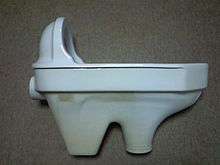
Squat toilets are arranged at floor level which requires the individual to squat with bent knees.[2] In contrast to a pedestal or a sitting toilet, the opening of the drain pipe is located at the ground level.
Squatting slabs can be made of porcelain (ceramic), stainless steel, fibreglass, or in the case of low-cost versions in developing countries, with concrete, ferrocement, plastic, or wood covered with linoleum.[3][4] Slabs can also be made of wood (timber), but need to be treated with preservatives, such as paint or linoleum, to prevent rotting and to enable thorough cleaning of the squatting slab.[4]
There are two design variations: one where the toilet is level with the ground, and the other where it is raised on a platform approximately 30 cm (1 ft).[5] The latter is easier to use for men to urinate while standing, but both types can be used for this purpose. There is also no difference for defecation or squatting urination.
Use
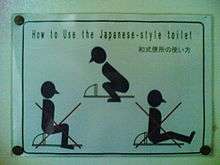
The user stands over the squat toilet facing the hood and pulls down (up in the case of skirts) their trousers and underwear to the knees. The user then squats over the hole, as close to the front as possible, as excrement tends to fall onto the rear edge of the in-floor receptacle if the user squats too far back; for this reason many public squat toilets have signs reminding the user to "Please take one step closer."[5]
Beginners and foreigners (i.e. people not used to squat toilets) often hold onto the piping at the front, which therefore has earned the nickname "grunt bar", from the sounds made while holding onto this pipe.[6]
Maintenance and hygiene
The standing surface of the squatting pan should be kept clean and dry in order to prevent disease transmission and to limit odors.[3]
Squat toilets are usually easier to clean than sitting toilets (pedestals), except that one has to bend down further if the squatting pan needs manual scrubbing. They can be cleaned by using a mop and hose, together with the rest of the floor space in the toilet room or cubicle.
One advantage of squat toilets is that they are very easy to clean. They are also cheaper to make, they consume less water per flush than Western toilets, and, due to the lack of direct contact with the seat, some people claim that they are more hygienic. However, seat contact is not a real health risk[7][8] and squat toilets allow splatter on one's own legs and feet. The waterless trough minimizes the risk of splash-back of water during defecation.
Society and culture
Perceptions
There are two different attitudes towards squat toilets, largely dependent on what users are used to, or whether the toilet is at a public or private place: Some people regard squat toilets as more hygienic compared to sitting toilets. They might be easier to clean and there is no skin contact with the surface of the toilet seat.[9] For that reason, some people perceive them as more hygienic, particularly for public toilets.
Some people regard sitting toilets as "more modern" than squat toilets.[9] Sitting toilets have a lower risk of soiling clothing or shoes as urine is less likely to splash on bottom parts of trousers or shoes. Furthermore, sitting toilets are more convenient for people with disabilities and the elderly.[10]
Public toilets
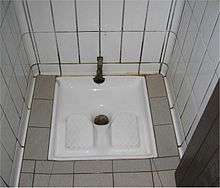
Squat toilets are used in public toilets, rather than household toilets, because they are perceived by some as easier to clean and more hygienic, therefore potentially more appropriate for general public use.[9][11] For instance this is the case in parts of France, Italy, Greece, or the Balkans, where such toilets are somewhat common in public toilets (restrooms).[11]
Trends
A trend towards more sitting toilets in countries that were traditionally using squat toilets can be observed in some urban and more affluent areas, in areas with new buildings (as well as hotels and airports) or in tourist regions.[9] This is very evident in Japan where the trend since the 1960s is to replace squat toilets at schools and public places with sitting toilets.[12] This trend is thought to accelerate in the run-up to the 2020 Tokyo Olympics and Paralympics.[12]
Preferences by country or region
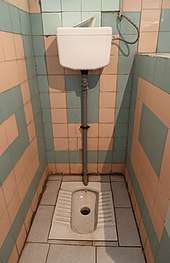
The following general statements can be made:
- Squat toilets are common in many Asian countries,[13] including Japan[5] and Thailand.[14] They are also widespread in Indonesia, India, Bangladesh, Pakistan, China, Singapore, Sri Lanka, Malaysia, Myanmar, Iran and Taiwan.[15]
- People in sub-Saharan African countries, especially in rural areas, widely use squat toilets, for example in Kenya, Rwanda, Somalia, Tanzania, and Uganda.[9]
- Much of the world's population use squat toilets, especially in rural areas of developing countries.
- Countries in the Middle East and North Africa seem to often have both types of toilets, i.e. sitting and squatting.
- In Muslim or Hindu cultures the prevalence of squat toilets is generally quite high, as is the practice of anal cleansing with water.[9]
- In Latin and South America flush toilets are always of the sitting type, whereas dry toilets may be either of the sitting or a squatting type. The occurrence of squat toilets in urban areas of Latin America appears to be rather low.
- Squat toilets are very rare in Australia, New Zealand, United States, Canada and countries in Northern and Western Europe.[9] Where they do exist, they have usually been installed to accommodate visitors, tourists, students or recent migrants from Asia. These cases are still so rare that newspapers report about them: Examples include cases from the University of Melbourne[16] (Australia), the University of Auckland[17] (New Zealand) and national parks in the United States such as Yellowstone National Park[18] and Arches National Park.[19]
Europe
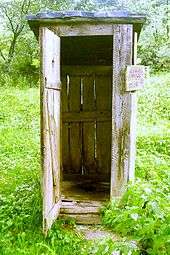
In Southern and Eastern Europe including parts of France, in Greece, Albania, Balkans, and Russia they are common, especially in public toilets.[20] Squat pit latrine toilets are present in some poor rural areas of Eastern Europe.
Squat toilets are generally non-existent in Northern and Western Europe.[9] France and Italy are an exception and have some squat toilets remaining in old buildings and public toilets because they used to be the norm there in the early 20th century.[1]
China
Many areas in China have traditional squat toilets instead of sitting toilets, especially in public toilets.[21] Nevertheless, sitting toilets have increasingly become the norm in major urban areas and cities.[21] Sitting toilets are on the one hand associated with development and modernization, and on the other hand with reduced hygiene and possible transmission of diseases.[21]
Japan
The trend in Japan is to move away from squat toilets: According to Toto, one of Japan’s major toilet manufacturers, the production of Western-style toilets increased rapidly since 1976.[12] In 2015, only 1% of all toilets produced by this company were squat toilets.[12]
Since the 1980s high-tech sitting toilets are emerging that replace traditional squat toilets, especially in urban areas. One of those toilets with the brand name "Washlet" includes a "posterior wash" before wiping and features heated toilet seats. However, many rural people have no experience with such high-tech toilets and need detailed instructions.[22]
Gallery
.jpg) Typical toilet in urban Syria: Flush toilet squatting pan with hose on the left for anal cleansing.
Typical toilet in urban Syria: Flush toilet squatting pan with hose on the left for anal cleansing.- Public squat toilet in Tsarskoe Selo, Russia
 Squat toilet in a CRH1A trainset on the Guangshen Line in China
Squat toilet in a CRH1A trainset on the Guangshen Line in China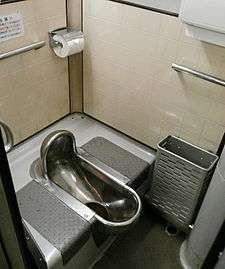 Squat toilet aboard a Japanese Ginga train
Squat toilet aboard a Japanese Ginga train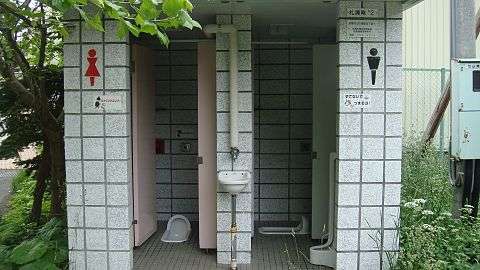 Public toilet at Jozankei Hot Springs, Hokkaido, Japan
Public toilet at Jozankei Hot Springs, Hokkaido, Japan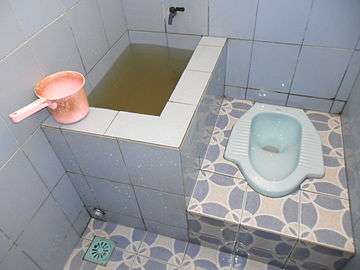 Squat toilet in Indonesia
Squat toilet in Indonesia_(5600799213).jpg) Squat toilet with seat for old people or for people with disabilities
Squat toilet with seat for old people or for people with disabilities.jpg) Hybrid toilet that can be used in squat mode
Hybrid toilet that can be used in squat mode
See also
References
- Gershenson, Olga; Penner, Barbara (2009): Ladies and gents - Public toilets and gender. Temple University Press, Philadelphia, Pennsylvania.
- Burns, Anthony S.; O'Connell, Colleen (2012). "The challenge of spinal cord injury care in the developing world". The Journal of Spinal Cord Medicine. 35 (1): 3–8. doi:10.1179/2045772311Y.0000000043. PMC 3240914. PMID 22330185.
- Tilley, E.; Ulrich, L.; Lüthi, C.; Reymond, Ph.; Zurbrügg, C. (2014): Compendium of Sanitation Systems and Technologies - (2nd Revised Edition). Swiss Federal Institute of Aquatic Science and Technology (Eawag), Duebendorf, Switzerland: 44. ISBN 978-3-906484-57-0. Retrieved 31. August 2015
- Reed, Brian; Shaw, Rod (2011). G005: Latrine slabs - an engineer's guide. Loughborough, UK: WEDC. p. 11. ISBN 9781843801436. Retrieved 8 April 2015.
- "Japanese toilets". Japan-Guide.com. Retrieved 16 October 2018.
-
Curtis Hoffmann (1992). "More on Living in Japan". Retrieved 2006-11-07. Cite journal requires
|journal=(help) - "Myth: Toilet Seats Are the Dirtiest Thing in the Bathroom". ABC News original report. ABC News. October 14, 2005. Retrieved 2006-11-13.
- "Lifting the lid on computer filth". BBC News. March 12, 2004. Retrieved 2006-11-13.
- von Münch, E.; Milosevic, D. (2015): Qualitative survey on squatting toilets and anal cleansing with water with a special emphasis on Muslim and Buddhist countries by using the SuSanA discussion forum. Ostella Consulting, Schwalbach, Germany
- "Fear of public squat toilets confines elderly to homes". South China Morning Post. 15 March 2006. Retrieved 1 May 2019.
- Olmert, Carol (2008). Bathrooms Make Me Nervous: A Guidebook for Women with Urination Anxiety (shy Bladder). Bathrooms Make Me Nervous. ISBN 9780615240244.
- "Japan Phasing Out Squat Toilets". Nippon.com. 8 January 2019. Retrieved 13 February 2018.
- Lechner, Norbert (2012): Plumbing, Electricity, Acoustics - Sustainable Design Methods for Architecture. John Wiley & Sons, Hoboken, New Jersey.
- Lonely Planet Southeast Asia on a Shoestring. Lonely Planet. 2014. ISBN 9781742207537.
- Chang, Jin-Soo (2014). "The Cultural and Environmental Unsoundness of the Chinese Public Squatting-Type Toilet: A Case Study toward a Sustainable Excreta Treatment System". Environmental Engineering Research. 19 (2): 131–138. doi:10.4491/eer.2014.19.2.131.
- "How to poop the right way – Scientific Scribbles". blogs.unimelb.edu.au. Retrieved 2018-11-05.
- Dye, Stuart Dye, Stuart (2004-12-19). "University bends to provide 'squat' toilet option". NZ Herald. ISSN 1170-0777. Retrieved 2018-11-05.
- Mullen, Maggie. "You Might (Not) Want To Sit Down For This: Squat Toilets Solve Potty Problem In Yellowstone". Retrieved 2018-11-05.
- "Squat toilets, helicopters and $12K worth of toilet paper: How national parks deal with human waste from visitors | KSL.com". Retrieved 2018-11-05.
- Olmert, Carol (2008): Bathrooms make me nervous. A guidebook for women with urination anxiety (shy bladder). CJOB Publications, Walnut Creek, California: 61.
- Tobin, Joseph; Hsueh, Yeh; Karasawa, Mayumi (2009): Preschool in Three Cultures Revisited: China, Japan, and the United States. University of Chicago Press, Chicago, Illinois.
- Cavusgil, S. Tamer; Rammal, Hussain; Freeman, Susan (2012): International Business: The New Realities. Pearson, Australia
External links
| Wikimedia Commons has media related to Squat toilets. |